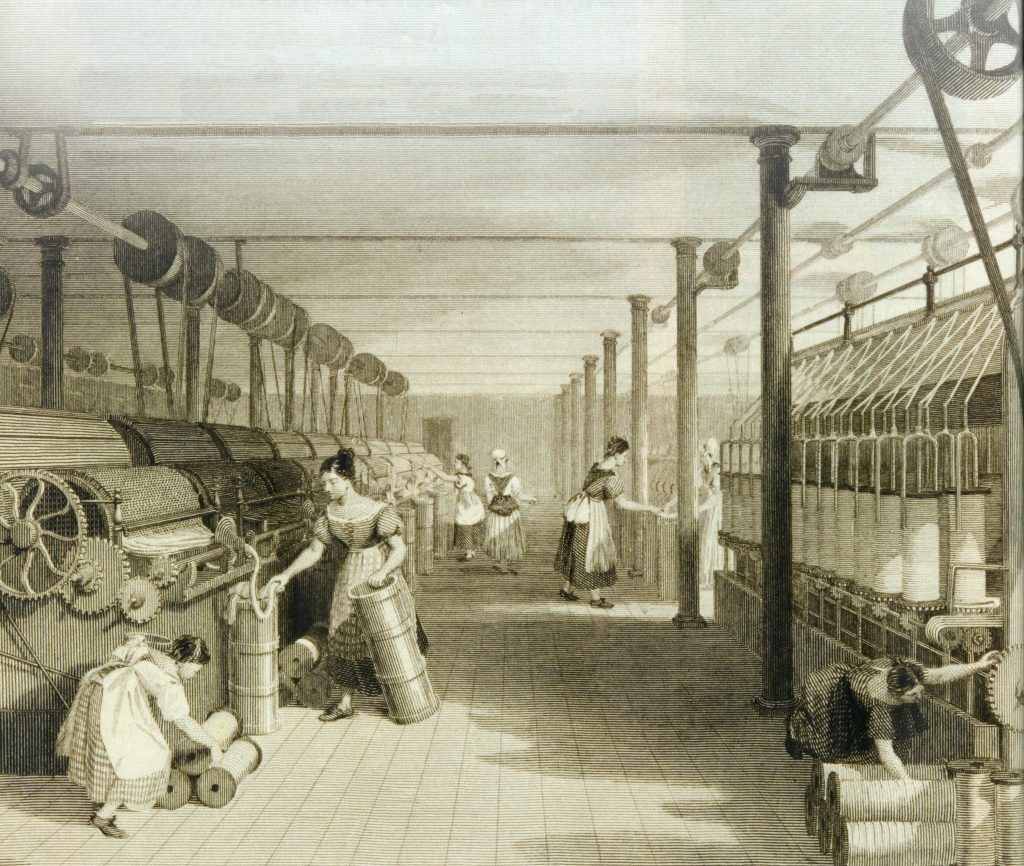Children today spend five days a week going to school for eight hours. During the first half of the nineteenth century in Britain, this was not the case. Instead, children even as young as five or six would toil all day long in factories or in mines. They had no breaks, no time off, and no schooling. Their work often led to horrible accidents, children being injured for life, and children left without an education.
Children laboring, of course, did not start with the British Industrial Revolution. It had been a normal part of life in Europe since the middle ages, when children helped their parents on farms and with household work. The people’s perception of this work, however, changed during the Industrial Revolution, since that is when people began to see this new kind of labor, factory labor, as an injustice and even criminal.1
The Industrial Revolution began in Britain during the 1780’s and rapidly changed the work process and the social relations of work. Prior to the Industrial Revolution, most people worked directly in the production of food, usually as farmers on their own farms. When textile factories began forming in the new factory cities, instead of working on their farms and making what their family needed, people left their farms and moved into the factory cities to make a living. Factory conditions of work, however, were far different from the work rhythms of farm life. In fact, they were brutal in comparison. Factory workers would typically put in between 12 and 16 hour days, working for meager wages. The machines they attended were dangerous, and the workers were often on their feet throughout the day, with perhaps a half-hour break for meals. Among these workers were children, many of whom were as young as five or six years old. Children were valued as workers for their small stature and ability to climb into small places and do things that adults often could not do. This often resulted in mutilation and the loss of appendages for many of these children.2
Children were also valued as workers by the factory owners because of the low wages that they were paid. Men were paid the most in factories, followed by women and then children. These wages, however small, were needed by the families of these children simply to survive. The parents often sent their children out to work to help pay for rent, food, and otherwise help make ends meet.3
One reason that the British public became outraged by child labor practices was the fact that children in factories were not receiving an education. Horace Mann, an American educational reformer, stated:
No greater calamity can befall us as a nation than that our children should grow up without knowledge and cultivation. If we do not prepare them to become good citizens, develop their capacities, enrich their minds with knowledge, imbue their hearts with a love of truth and all things holy, then our republic must go down to destruction as others have gone before it.4
This represents the thoughts of the British at the time, which was being echoed in the United States during its own industrial revolution. People wanted to ensure the future of their nation, which starts with the young. They believed that children should attend school for at least a while.5 This led to several laws being passed to raise the legal age of work.
In 1833, the British Parliament passed the Regulation of Child Labor law to help improve the working conditions for children in factories. The Law limited the age of workers, saying that they had to be older than nine with an age certificate to prove it, and that children 9-13 could not work for more than nine hours a day. Additionally, children 13-18 were not permitted to work longer than twelve hours a day. Along with these work-hour restrictions, the law also made school attendance a two-hour requirement, and said that children could not work at night. Fines for breaking these rules were small, however, so they were frequently violated, often with impunity.6

Many other pieces of legislation were also passed to place limits on the gender, hours, and ages of workers. The Mining Act of 1842 prevented women and girls from working in mines, and the Ten Hours Bill of 1847 set ten as the maximum number of daily working hours for women and children. This act was hated by factory owners because they believed it would hurt the textile industry’s competitiveness worldwide. After these bills, others followed to ensure their effectiveness, and to ensure that they would be properly implemented.7
By 1900, the minimum working age had been raised to twelve years of age and child labor had decreased drastically in Great Britain. However, the introduction of legislation against child labor provoked its share of protests as well. Because of these protests, Parliament established commissions to collect evidence of abusive practices. These were called the Blue Books or Sadler Reports. They interviewed children, parents, factory workers, owners, and even doctors on the condition of children in textile factories. Unsurprisingly, the reports uncovered a range of serious abuses by factory owners and overseers. Unfortunately, most critics just said that the claims were exaggerated in order to continue their money making practices.8
The legislation surrounding the British Industrial Revolution had become very effective by 1900, and child labor and its accompanying abuses had decreased dramatically. By 1900, most children were attending school instead of working in factories. The laws passed finally added up to changing British child labor to being closer to what we see today, a mostly child-free labor system, with children going to school and adults having regulated working hours.
- World History Encyclopedia, 2011, s.v. “Child Labor and Child Labor Laws in Early Industrial Great Britain.” ↵
- James D. Schmidt, “Broken Promises: Child Labor and Industrial Violence,” Insights on Law & Society, no. 3 (Spring 2010): 14–17. ↵
- Robert Whaples, “Hard at Work in Factories and Mines: The Economics of Child Labor during the British Industrial Revolution,” Business History Review, no. 2 (2001): 429. ↵
- Friends’ Intelligencer vol. 28 no. 1 (1871): 336. ↵
- James D. Schmidt, “Broken Promises: Child Labor and Industrial Violence,” Insights on Law & Society, no. 3 (Spring 2010), 14–17. ↵
- Great Britain, “Factories Regulation Act” (1833). ↵
- Steven Toms and Alice Shepherd, “Creative Accounting in the British Industrial Revolution: Cotton Manufacturers and the ‘Ten Hours’ Movement,” MPRA Paper, No. 51478 (2013), 6-8. ↵
- World History Encyclopedia, 2011, s.v. “Child Labor and Child Labor Laws in Early Industrial Great Britain.” ↵



141 comments
Nicolas McKay
Great job on your article Bailey.I am familiar with the struggles of child labor within the United States, but I knew little about its occurrences in other countries. It is certainly tragic to think of all that these poor children were forced to endure, and all at such a young age as well. My baby sister just recently turned ten, and I could never imagine her being forced into such hazardous and outrageous conditions. You did a great job telling the tragic plight of these poor children.
Marissa Gonzalez
Great job on this article because it was very descriptive. It is hard to imagine putting yourself in conditions like the children were in their jobs. It is a good thing that the government started enforcing laws that protect the rights of the workers no matter how old they are. Allowing children to have the right to go to school was also a good realization. This is the second time reading this article and it was still engaging. Good job!
Irene Astran
I appreciate the angle you took with this angle. I think if you wanted to truly illustrate how taxing this work was for the children and how dangerous the work was you could have added more pictures of the equipment they worked with. You could have also described how often it was for the children’s lives to be taken by these machines by simple mistake. Not suggesting you should have turned this article into a gruesome horror story, but you definitely could have added that perspective.
Ana Gonzalez
I’m glad that the government realized that they cannot be employing young children and exposing them to unsafe and dirty situations that could result in injuries or even death. Your article was interesting and I’m glad you chose this topic because it is not talked much about and it certainly shaped the way our society works and how age is perceived.
Thankyou for your article! Hope you win Awards!
Zander Barrera
it is really just unfair and cruel that a society would use the most innocent of our ranks, Children, for personal gain and economic competition. the image of seeing kids crawling over sharp and dangerous machines, losing limb and appendage or suffering down in mines, working to death for scraps compared to the actual profit made by their employers is just repulsive. that being said you did right by telling these children’s story and making the message clear that we do not have it nearly as hard as they did. very nice article good pictures showing the factory scene.
Jennifer Pogue
Awesome article! I really liked the way your organized this article, it helped tell your story. I cannot imagine kid’s having to work in those conditions today. I can’t even imagine how they were able to do it then. Every little kid I know likes to play pretend, gets distracted easily, and needs their parents to help them do most things. It makes me sad that these kids had to do such hard work at such a young age, but I really wonder how they were able to do it. They must have had very harsh punishments for not doing as they were told.
Zaraly Frasquillo
I find it impossible to think of a time in where kids did not have to go to school and had to work instead, but I am wrong it happened, and it continues to happen in third-world countries. Bailey your introduction was very eye catching and it was the main reason I decided to read your article. I look back in time and i realize that the world we know is fairly new, since all of our human right laws and stuff just appeared in the 20th century. Great job!
Alyssa Vela
The first time I read this article I was so flabbergasted at just how much children within this time period endured! I can’t imagine living within this time period. I’m glad that education is being stressed so much, because the thought of having to put innocent children through that kind of labor in such poor conditions makes me so sad. This time reading I still managed to note how well you did at expressing your emotions and managing to make your readers feel and see things through your point of view. I can totally understand why this was nominated for “Best in Social History”!
Aimee Trevino
I really enjoyed your article! It is insane to think that children as young as five were being sent out to dangerous conditions to work. It is interesting to see how these laws can be implemented in just a couple decades. More so, it is interesting to compare these young children working, to children across the globe in today’s society working. Great topic!
Briana Bustamante
Very interesting article. I enjoyed reading it the second time around. I understand why your article was nominated as the best in the “World History”, and “Social History”. I still find it shocking how young children as young as five or six years old were working in such horrible conditions. As a future educator I find it heart breaking, because I care so much for children. Thankfully people started to realize how wrong this was and the situation was corrected.